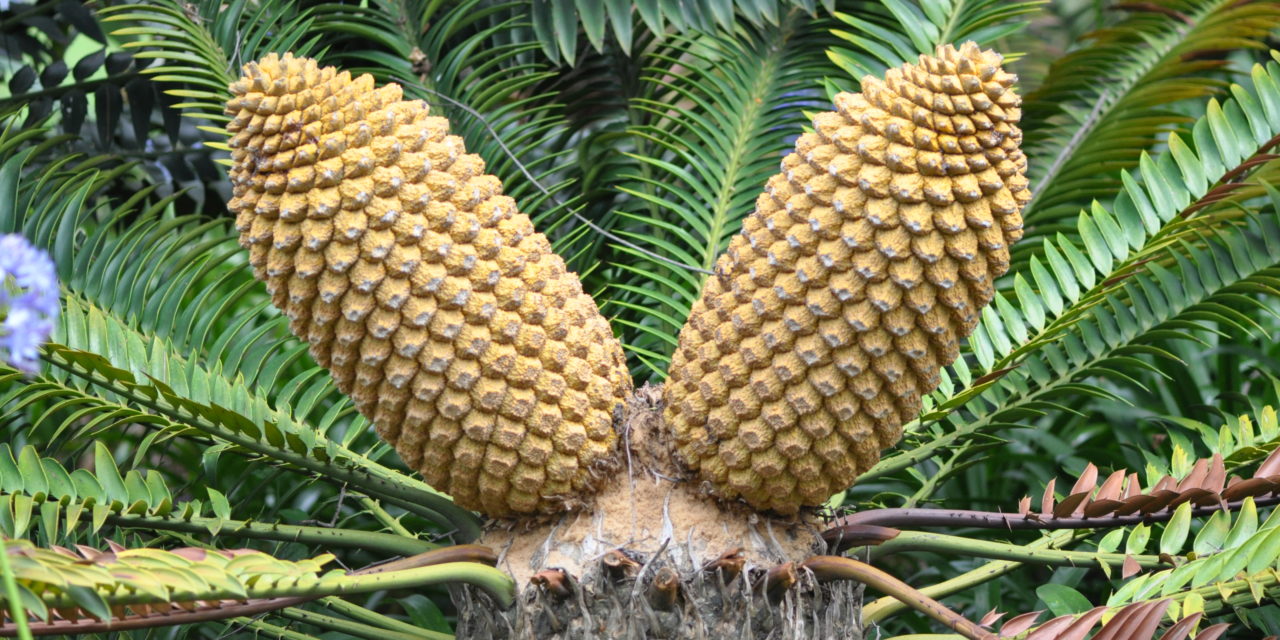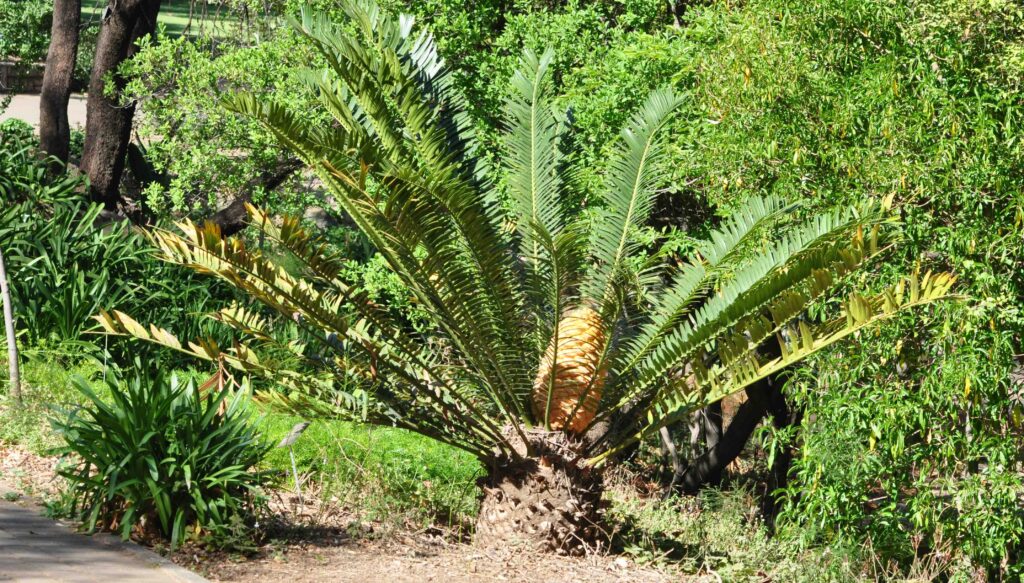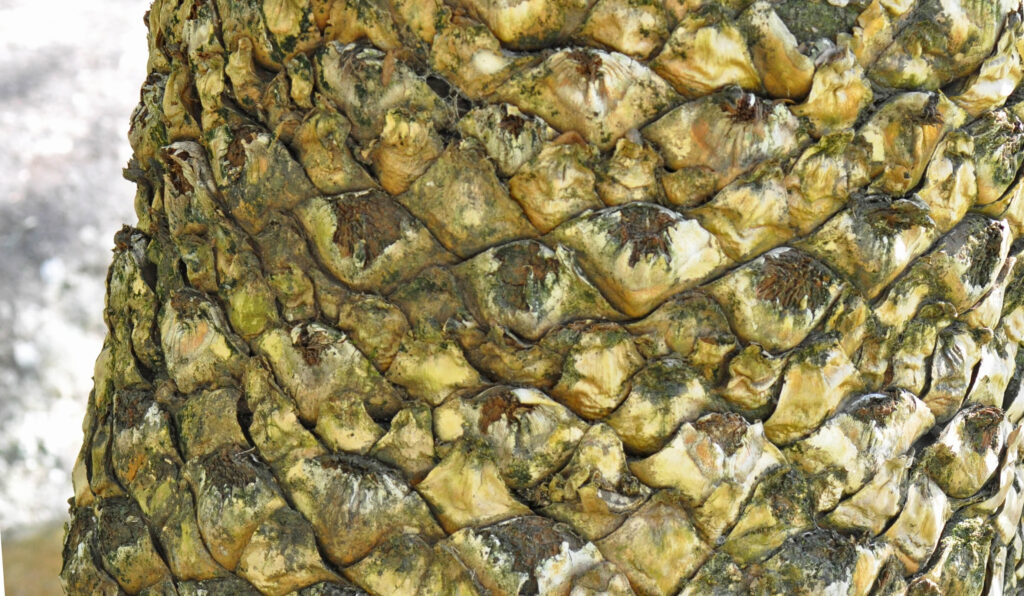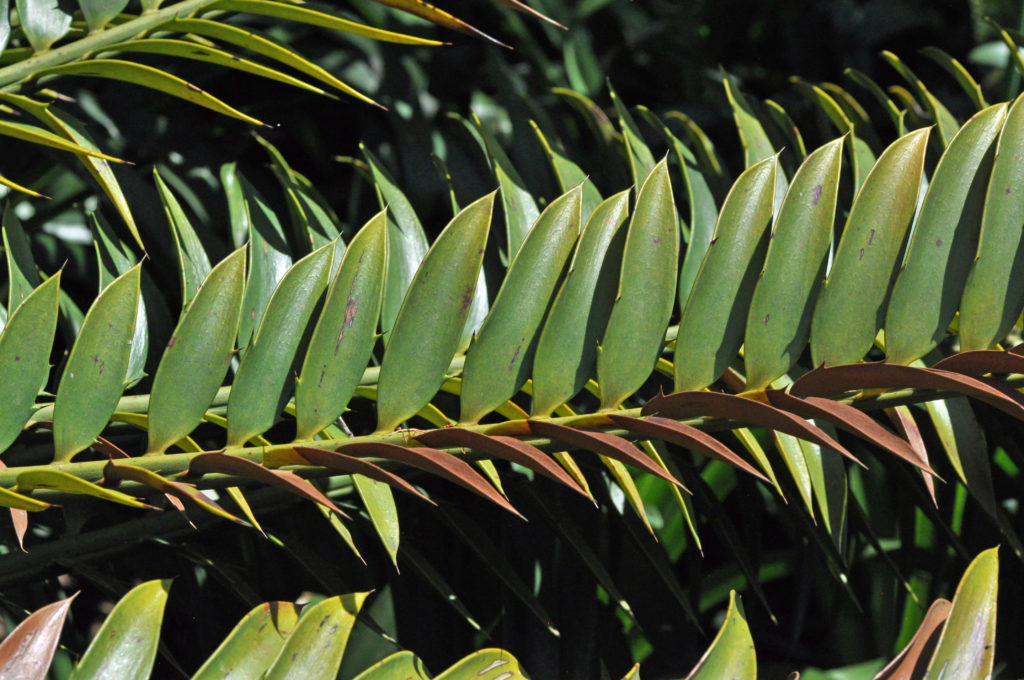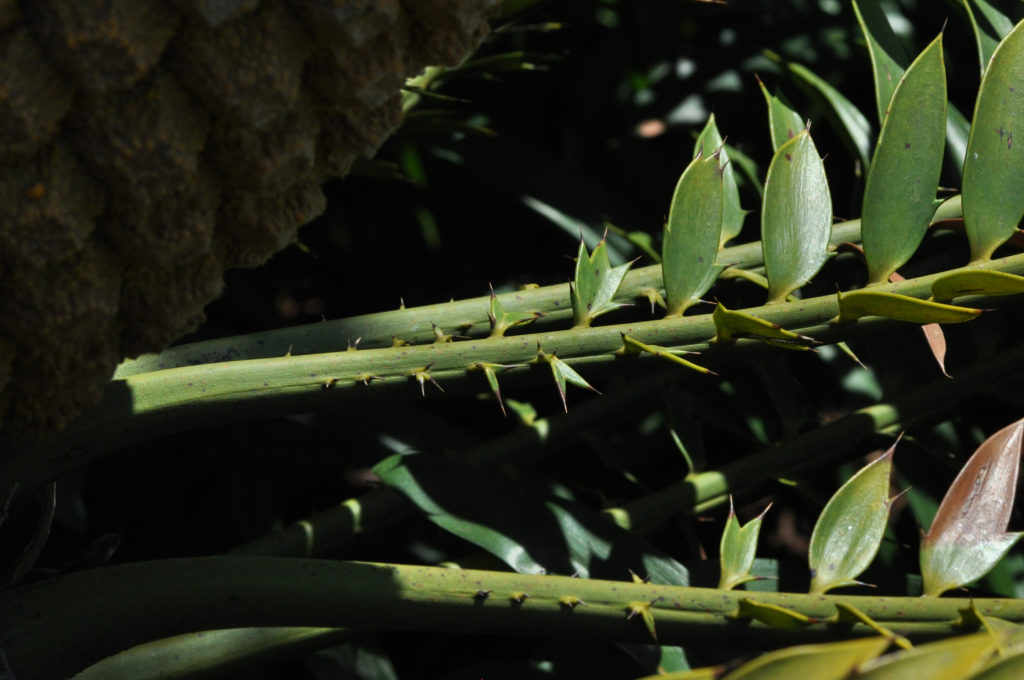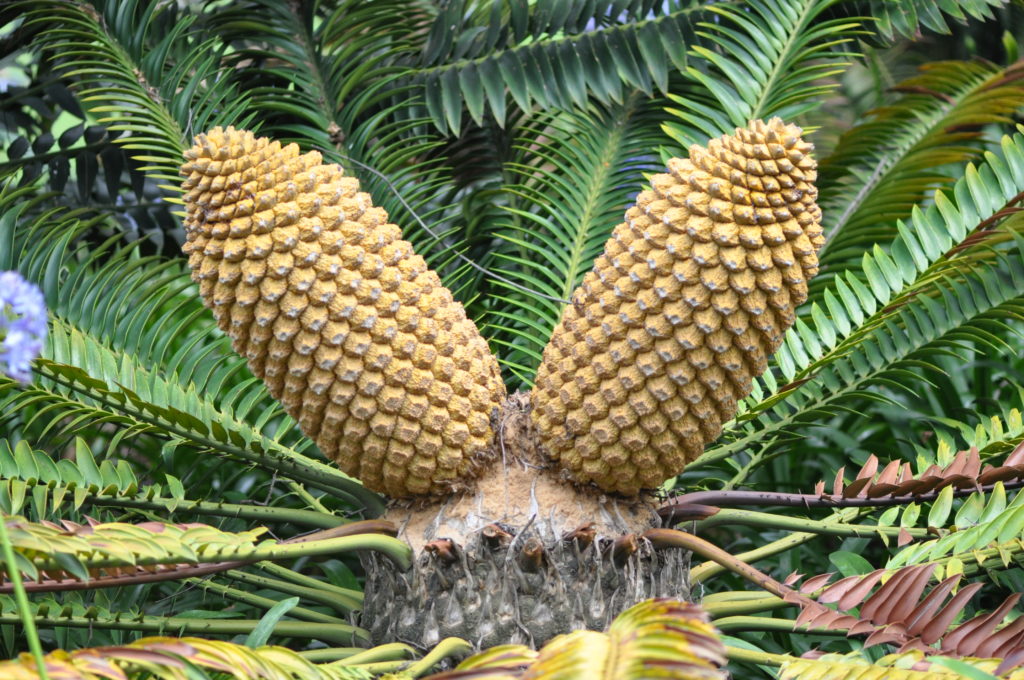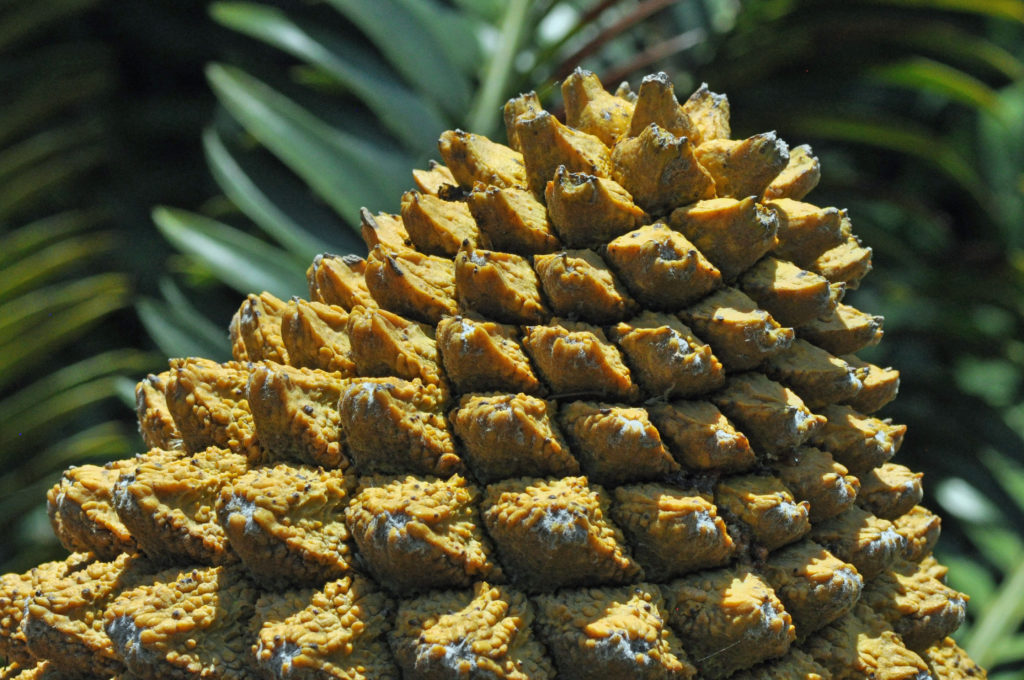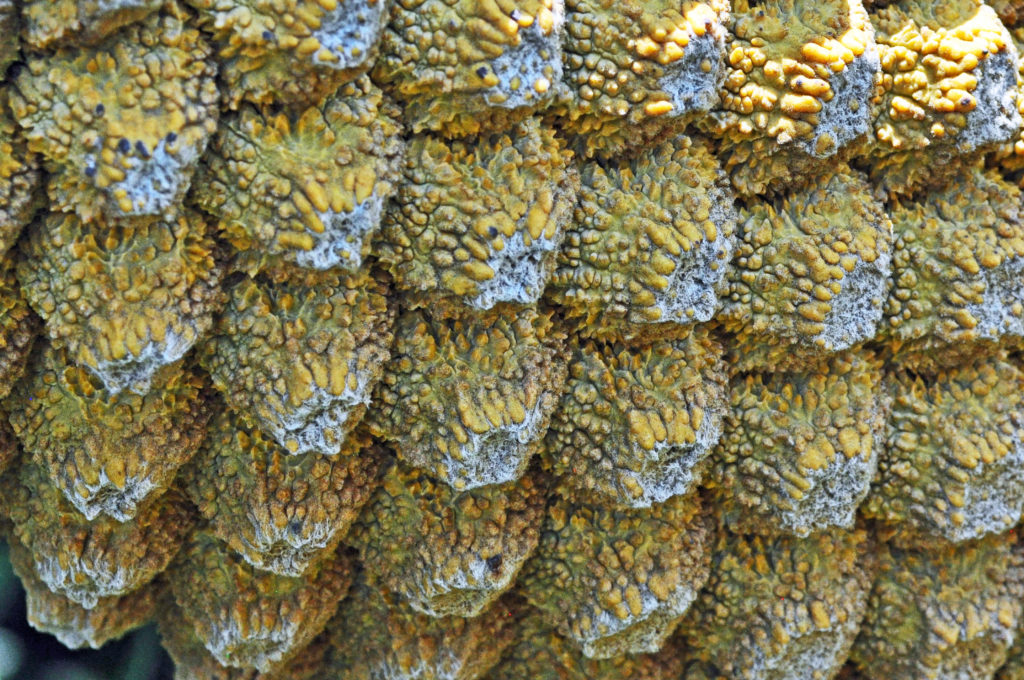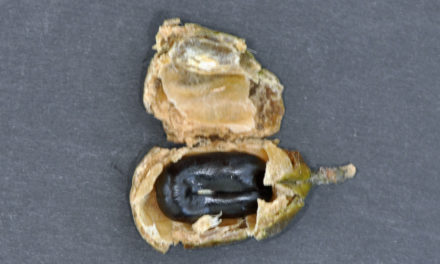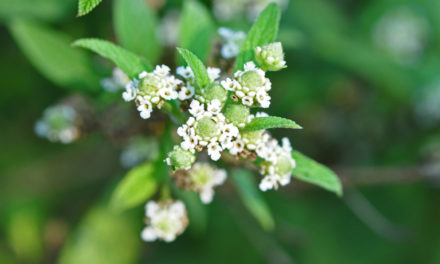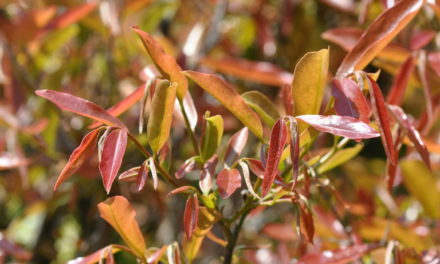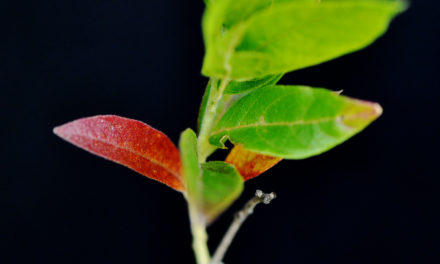General Info – summary
This dioecious Tree is up to 7m high with a trunk diameter to 40cm. Plants grow away from the sea. The main stem may recline. The pinnately compound glossy green Leaves are up to 3m long. All leaflets lack a midrib, & the lowest leaflets are reduced to prickles. Cylindrical Male Cones are smaller than the almost oblong Female Cones, which disintegrate releasing up to 500 large (up to 3,5 x 2cm) scarlet Seeds.
Description
Encephalartos natalensis
SA Tree No. 10.
Common Names: (Afr) Brodbloom, Natalbroodboom, Natal-broodboom, Reusebroodboom. (Eng) Giant Cycad, Natal Cycad, Natal Giant Cycad. (isiXhosa) Umguza, Umphanga. (isiZulu) Isigqikisomkhovu, Isidwaba-somkhovu, Umhlungulo, Umngquabe.
Family: Zamiaceae. This family is part of the major group: Gymnosperms. Zamiaceae are usually cone-bearing plants producing naked seeds and include Ginkgo (in China), Cycads, Conifers (e.g., pine trees) and Gnetophytes: e.g., the unique Welwitschia mirabilis (tweeblaarkanniedood) are not wind pollinated and found in the deserts of western Namibia and southern Angola. Members of the gymnosperm family Zamiaceae have no flowers or fruit and the seeds are often contained in Cones. This family has 8 genera, including the Genus Encephalartos, which contains all species of cycads.
Name derivation: Encephalartos – within-head-bread: referring to the starchy bread that can be made from the pith of the inner trunk. natalensis – from Natal province – now Kwa-Zulu Natal. All cycads fall into the genus Encephalartos, which includes some of the most primitive living Gymnosperms. This tree was only named in 1951. The African plants in the genus Encephalartos include about 66 species and 35+ species occur in southern Africa.
Conservation: National Status: N T. Near Threatened. Assessment Date: 2009 (J. S. Donaldson). Illegal harvesting and use in the traditional medicine trade have had an effect.
Tree
The Stem (main axis of the plant, the leaf and flower bearing as distinguished from the root-bearing axis) may have a single axis or more than one may arise from the base. Growth is relatively quick. The Tree may reach 4-7m high and the trunk may be up to 40cm wide. When more than 1 stem is present, the main stem may recline. Only leaf scars remain visible on the trunk, when the entire leaves eventually fall.
- 155: 2019/09/03. Walter Sisulu NBG. Photo David Becking.
- 776: 2014/09/15. Lowveld NBG. Photo David Becking.
Leaves
Cycads are unique Gymnosperms with evergreen, palm like pinnately compound Leaves (here the leaflets are arranged along either side of the leaf rachis, the central stalk, like a feather). Unlike other members of the family Zamiaceae, the cycads have leaflets that lack a central Midrib (vein). The hard leaflets do not bend easily, and the leaflet Veins are parallel (photo 777). Stomata (structure utilising 2 guard cells that, unlike lenticels, can control gaseous exchange) are present on the lower surface and may occur above.
This Natal cycad has glossy-green leaves that are erect and spreading – up to 3,2m long with a Rachis (in this case the central axis bearing leaflets) that may twist close towards the leaf end. The broad, usually spaced apart leaflets (photo 1000), near the centre of the leaf are the largest– up to 23 x 4,5cm. In this photo, the pointed leaflet Apices are visible. Where the new leaves or cones arise, the woolly brown hair on the crown becomes denser (photo 133 under Cones). Leaflet Margins may have up to 5 prickles on one or both sides (photo 996). Towards the Leaf Base, the leaflets become gradually reduced in size to prickles (photo 996). This differs from E. altensteinii – where no reduction occurs.
- 777. 2014/09/15. Lowveld NBG. Photo: David Becking.
- 1000: 2017/11/14. Pretoria NPG. Photo David Becking.
- 996: 2017/11/14. Pretoria NPG. Photo David Becking.
Cones
All Gymnosperms have unenclosed or naked seeds. They have no flowers or fruit, and the seeds are often contained in cones. In the Angiosperms (flowering plants), the seeds are enclosed in an ovary. In the Gymnosperms, there are 2 modes of fertilization. In all the Cycads (including Encephalartos) and the single extant (not extinct) plant Ginkgo biloba, the male cones produce motile sperms, which do not move along a pollen tube. The remaining members of the Gymnosperms all have non-motile sperm with no flagella, which are moved along a Pollen tube to the egg. All cycads are Dioecious (having male and female cones on separate plants).
Encephalartos natalensis plants produce 2-3 orange-yellow cones on the separate male and female plants. These cones develop in the centre of the leaf whorls. Young cones are covered with brown hairs and each cone rests on a yellow stalk. Male Cones are cylindrical, velvety and usually about 45 x 11cm in size. Pollen is shed from April to June. The larger Female Cones (photo 133) are oblong to oblong-ovate,-and about 55 x 25cm. Faces of cone scales are wrinkled (photos 999 & 997). When mature the female cones disintegrate, exposing and releasing up to 500 naked Seeds. Each scarlet seed is up to 3,5 x 2cm.
- 133: 2017/11/14. Pretoria NPG. Photo David Becking.
- 999: 2017/11/14. Pretoria NPG. Photo David Becking.
- 997: 2017/11/14. Pretoria NPG. Photo David Becking.
Distribution & Ecology
This plant is Endemic (endemic – restricted to a particular geographic location) in South Africa. These Trees occur mainly in inland areas from Tabankulu – Northwest of Port St Johns in the Eastern Cape to Vryheid in northern KwaZulu-Natal. They do not occur close to the sea and can be seen in the gorge below the Howick Falls (KwaNogqaza) – about 10km NW of Pietermaritzburg. Here the palm-like leaves make them easy to recognise in this area. They grow in Krantzes (encircling or overhanging wall of rock) and rocky valleys in an altitude region of about 1 200m. The trees are frost hardy. The Leopard Magpie Moth (Zerenopsis lepida) is yellow with large dark dots and can severely damage the young leaves of this and many other cycads. These moths may cause a major problem with cultivated cycads. The bats, baboons, monkeys and trumpeter hornbills collect and eat the outer part of the Fruit and disperse the leftover, poisonous Seeds.
Ethnobotany
This Cycad is relatively quick growing and leaves may reach 1,5m long in 3 years. Plant young trees in rocky, somewhat shady, areas. The sex of the future tree is difficult to determine before the cones appear. All Seeds are poisonous. They produce carcinogenic and neurotoxic glycosides (cycasins). These are poisonous to mammals – including man and seeds should only be handled with gloves.
References
Boon, R. 2010. Pooley’s Trees of eastern South Africa. Flora and Fauna Publications Trust, Durban.
Coates Palgrave, M. 2002. Keith Coates Palgrave Trees of Southern Africa, edn 3. Struik, Cape Town.
Donaldson, J.S. 2009. Encephalartos natalensis R.A.Dyer & I.Verd. National Assessment: Red List of South African Plants version 2020.1. Accessed on 2023/04/17.
Lawrence, G. H. M, 1951. Taxonomy of Vascular Plants. The Macmillan Company, New York. Tenth Printing 1965.
Palmer, E. & Pitman, N. 1972. Trees of southern Africa. Balkema, Amsterdam, Cape Town.
van Wyk, B. & van Wyk, P. 1997 Field guide to Trees of Southern Africa. Struik, Cape Town.
http://plantzafrica.com/plantefg/encephnatal.htm
https://www.bing.com/search?q=Encephalartos+natalensis&FORM=EDGEND
http://cycadfriends.co.za/site/cycad-database/encephalartos/encephalartos-natalensis/
http://pza.sanbi.org/encephalartos-natalensis
http://biodiversityadvisor.sanbi.org/wp-content/uploads/sanbi-identify-it/plants/encephalartos.htm
http://www.theplantlist.org/browse/G/Zamiaceae/https://www.diffen.com/difference/Angiosperms_vs_Gymnosperms
Leopard Magpie Moth (Zerenopsis lepida) – Insects | Candide Gardening

